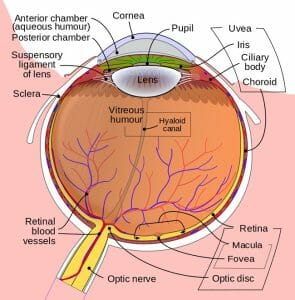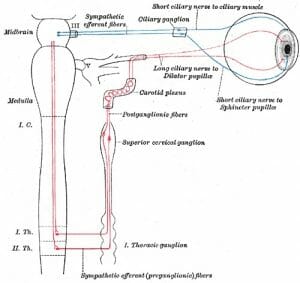Miosis Definition
Miosis is a medical term referring to the constriction of the pupil. Miosis is also known as myosis. Both terms refer to the closing of the pupil through the actions of small muscles in the eye. Miosis reduces the amount of light that enters the eye, which is necessary in daily life as the levels of light change in an organism’s environment. Miosis can also be induced by a wide variety of medicinal and recreational drugs, and is sometimes one of the diagnosing criteria for impaired driving arrests. Miosis is not to be confused with meiosis or mitosis, which are both forms of cell division.
Miosis Causes
The proximate cause of miosis, or the local actions that cause miosis are the relaxation and contraction of two muscles in the iris of the eye. The iris is the colored part of the eye, and is anchored just under the protective cornea. The iris dilator muscle and the iris sphincter muscle work against each other to adjust the size of the pupil, which is simply the hole in the middle of the iris that allows light to pass through. The light will pass through the lens, which focuses the image, and continue on to the back of the eye. The retina is a highly specialized tissue containing cells that can detect light. These cells pass the signal to the optic nerve, and onto the brain. The above components are labeled in the diagram below.
Some of the specialized cells in the eye are called photosensitive ganglion cells, and are responsible for sensing the ambient levels of light in the eye. The ganglion send a signal to the brain, and the autonomic nervous system automatically and continually adjusts the iris. If too much light is hitting the retina, miosis will occur and the pupil will constrict. For miosis to occur, the iris dilator muscle must relax, while the iris sphincter muscle contracts at the same time. This causes the pupil in the iris to shrink in size, effectively limiting the amount of light that enters the eye. If the pupil closes too much the ganglion cells will sense this, send the information to the brain, and the muscles will dilate the pupil. This is known as mydriasis, and is the opposite of miosis. The nerves that connect to the iris dilator and sphincter muscles runt through different parts of the brain, as seen the following diagram.
The ultimate causes of miosis can be variable. In most healthy and sober individuals miosis is simply a reaction to the amount of light the eyes receive. Because miosis is caused by a complex pathway that involves many nerve cells, chemicals, and different parts of the brain, miosis can also be induced by a variety of drugs, such as opioids, nicotine, antipsychotic medications, certain eye-drops, and a wide variety of other substances. Some of these drugs may cause anisocoria, or miosis in one eye and mydrasis in the other. The changes in available light caused by miosis and mydrasis due to drug use may contribute to the “altered perception” that use drug users claim to experience. Other times, miosis can be due to various diseases or other nerve tissue degeneration.
Miosis is not limited to the human eye. Miosis happens in all animals that have a mechanism to restrict the amount of light that enters the eye. Only two groups of animals have developed eyes like this, the vertebrates and the cephalopods. Other animals with eyes, like insects, do not use miosis because they do not regulate the amount of light that enters their eyes in the same way vertebrates and cephalopods do. Vertebrates include all organisms with a backbone, while the cephalopods include octopuses and their relatives. Although the structure and mechanisms of the eye are so similar that they undergo similar processes, scientist believe that the eyes arose through convergent evolution, or a similar evolutionary result caused by similar environmental pressures and environments.
Related Biology Terms
- Mydrasis – The opposite of miosis, or the dilation of the pupil.
- Anisocoria – When the pupils of the eyes are dilated to different sizes.
- Pupil – The opening in the iris, which lets light through the lens and onto the retina.
- Iris – A complex circular structure attached to two muscles, which controls the size of the pupil.
Quiz
1. A doctor shines a light into a patient’s eyes. The patient does not blink and the eyes do not undergo miosis. Can the doctor be sure the patient isn’t just sleeping heavily?
A. Miosis is a reflex action, and should be automatic, even during sleep.
B. No, the patient might just be having a good dream.
C. Light levels are only adjusted for during conscious thought, so the patient could just be asleep.
2. The iris dilator muscle just constricted, while the iris sphincter muscle just relaxed. What happened?
A. Meiosis
B. Miosis
C. Mydrasis
3. You are a Public Defendant, sworn to give the best legal guidance to even the most rotten criminals. The defendant you are currently defending got arrested for being “impaired while biking”, a most serious crime. The arresting officer’s only evidence was that your client’s eyes were showing extreme miosis. Which of the following is a reasonable defense?
A. Without more evidence that an intoxicant was the cause, miosis can be initiated by a number of causes.
B. The client was peddling slowing enough that the intoxication did not affect his driving.
C. Obviously, this guy should just bargain for the best deal and go to prison.


